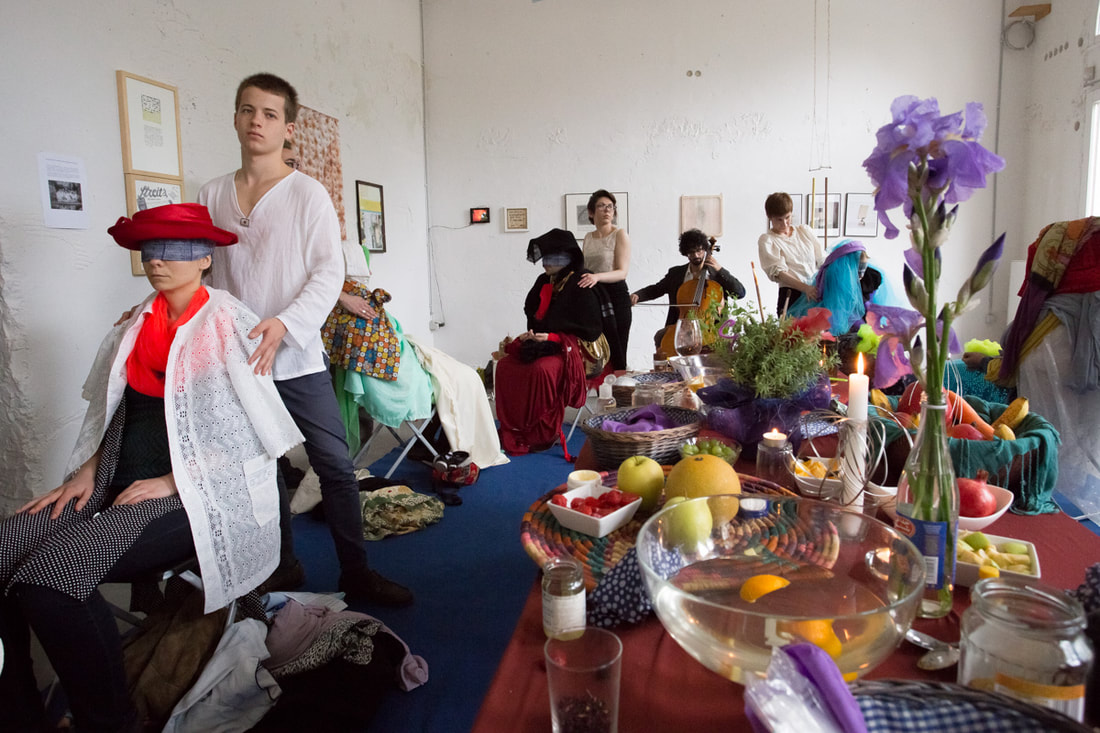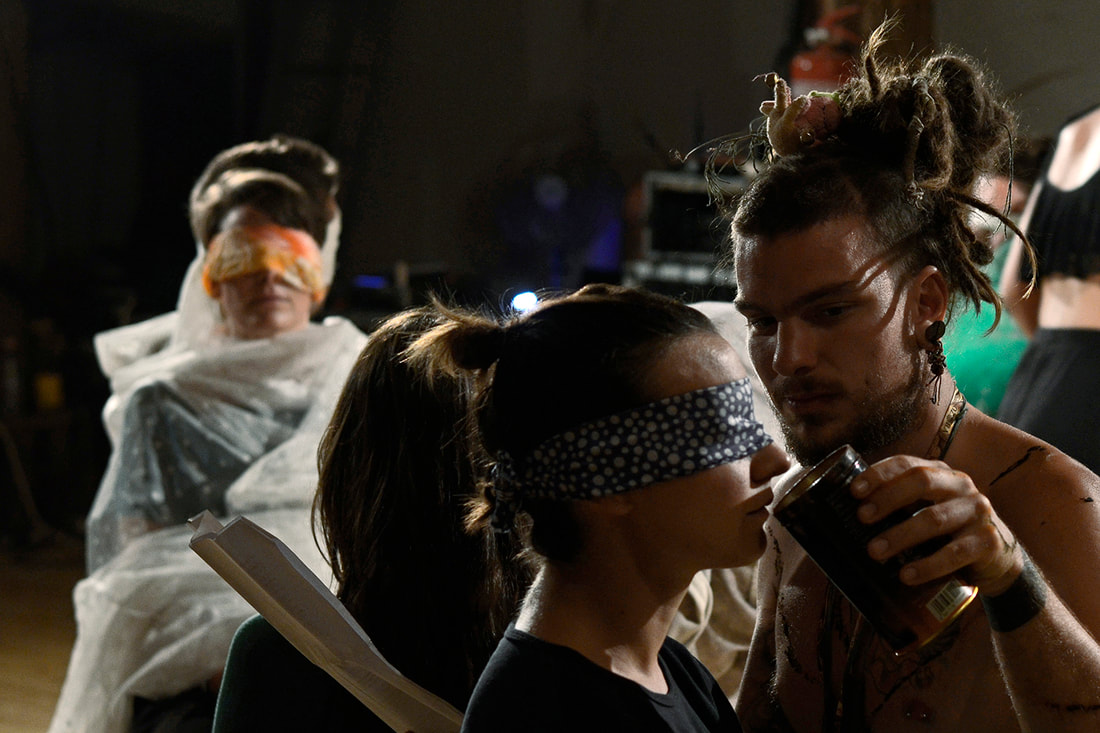Video 1 |
Video 2 |
Photos
Érzékek Éneke
|
Song of Senses
|
|
|
|
Script
|
Script
|
|
|
|
|
|
Koncepció
|
Concept
|
|
Az “Érzékek Éneke” egyszerre performansz és sámánikus rituálé egyben, melyben az előadók a legősibb és legösztönösebb gesztusaikra hivatkozva egy törzsi szertartásra emlékeztető ördögi lakomában részesítik a mindvégig bekötött szemű nézőt. A minden érzékszervére ható ingerektől, suttogástól, szagoktól, ízektől, transzcendens zenétől, simogató kezektől és rózsaolaj-illatú kényeztetéstől a néző egyfajta örvénylő hipnotikus extázisba kerül, amit már csak a rávarázsolt rituális jelmez felfedezése tud fokozni. A multiszenzoriális, immerzív, interaktív, egyszerre egyedi és messzemenően személyes élményt garantáló előadás újragondolja az előadó-befogadó viszonyt, párhuzamot von a beavató színház és a beavató szertartás között, és a közösségi interaktív előadást egyfajta kollektív energiákból táplálkozó rituális performanszként értelmezi.
Az “Érzékek Éneke” gyerekeknek és felnőtteknek egyaránt kikapcsolódás és belső utazás. |
In “Song of Senses”, we mix contemporary visual art, performing art, religious and pagan ritual practices linked to ceremonies, shamanic rites, spiritual beliefs, caring and healing. We explore how rituals embody and activate myths through dramatic and choreographic transformative devices, and how we can appropriate and traverse traditional boundaries between performance art, ancient rites, shamanic action and transcendental experiences to develop a new understanding of transmission and to make the public achieve transcendence in a contemporary profane context, in which emotion and sentiments replace dogma. Through an immersive experience, we expand the range and breadth of the understanding of transcendence and immanence of the sacred, make the public experience a unique multisensory ritual and feel the power of collective action.
Since its earliest treatment, transmission (of knowledge, religion, traditions…) has been linked to ritual practice, in which the conditions are generated by exciting feelings of collective effervescence. With classical music, whispers, slow gestures recalling a church service, the performance engages the audience in an internal struggle between individual and group identity, and reflects on the French sociologist Émile Durkheim’s writings, for who “collective representations (...) express collective realities; the rites are a manner of acting which take rise in the midst of the assembled groups and which are destined to excite, maintain or recreate certain mental states in these groups.” By using a set of props having strong symbolic meanings (fig/sinfulness, pomegranate/fertility, apple/temptation…), the performance is also a reaction to the symbolic and interpretive anthropology of Victor Turner, exploring the relationship between representations and forms of embodied experience and emotion. For him, “communion provides the context in which ritual participants are particularly receptive to the messages inherent in ritual symbolism”. In “Song of Senses”, the public is blindfolded, and the absence of delineated spatial, temporal and social spaces induce them in a heightened state in which they follow the rituals being enacted and guided by the lecture of extracts from the “Song of Songs”. Through reading this text to his/her audience, the performer confers to his/her spectator the role of the “admired”, the “beloved”, celebrates all kinds of love (without regard to the age, gender, race, national origin of his/her visitor), and responds to the American anthropologist Clifford Geertz’s idea, for who “rituals are a form of text which can be read. They are a way of “saying something of something” through objects and actions as well as words, and the feelings or “ethos” that rituals generate make the conceptions of a given culture’s religion more compelling”. By removing the performance “fourth wall” and blending performer and audience spaces, the performance is able to create an immersive experience with a minimal array of set design and props other than chairs and a table. The space in which the performance happens is understood as a three-dimensional narrative environment, enacting a joyful “Last Supper” or a sort of twisted dinner party from hell, both an ephemeral installation and a medium in itself, that makes use of an interconnected set of objects, but whose specificity is given by its historical, symbolical, sensory and spatial dimension. Artistic intention“Song of Senses”, a 30 minute ritual is a multisensory, interactive, immersive experience which may subject you to complete darkness, scents, flavours, noises and physical contact.” - said a spectator about the performance.
In the form of a total artistic interactive and immersive experience, in “Song of Senses” we create social and spatial contexts, develop new forms of collective aesthetics based on interactivity, participation, connection, and physical presence. Situated between relational aesthetic, forgotten rituals and magical practices, “Song of Senses” allows the participants to immerse themselves in a hybrid space, step from a “classic” spectatorship to a co-author of the art work (depending on how actively they want to interact with the performers and/or with other participants), or even becoming the artwork itself. Through this dispositif, our objective is to:
|


